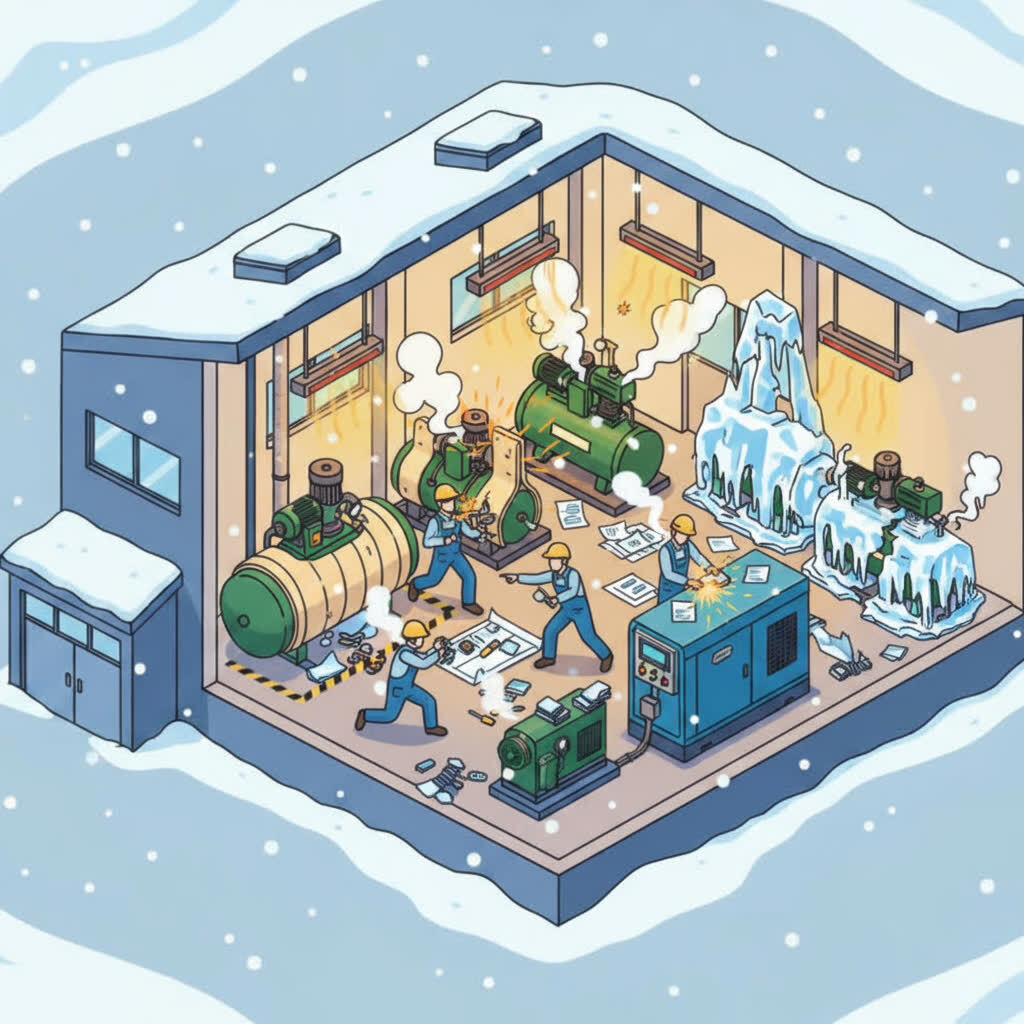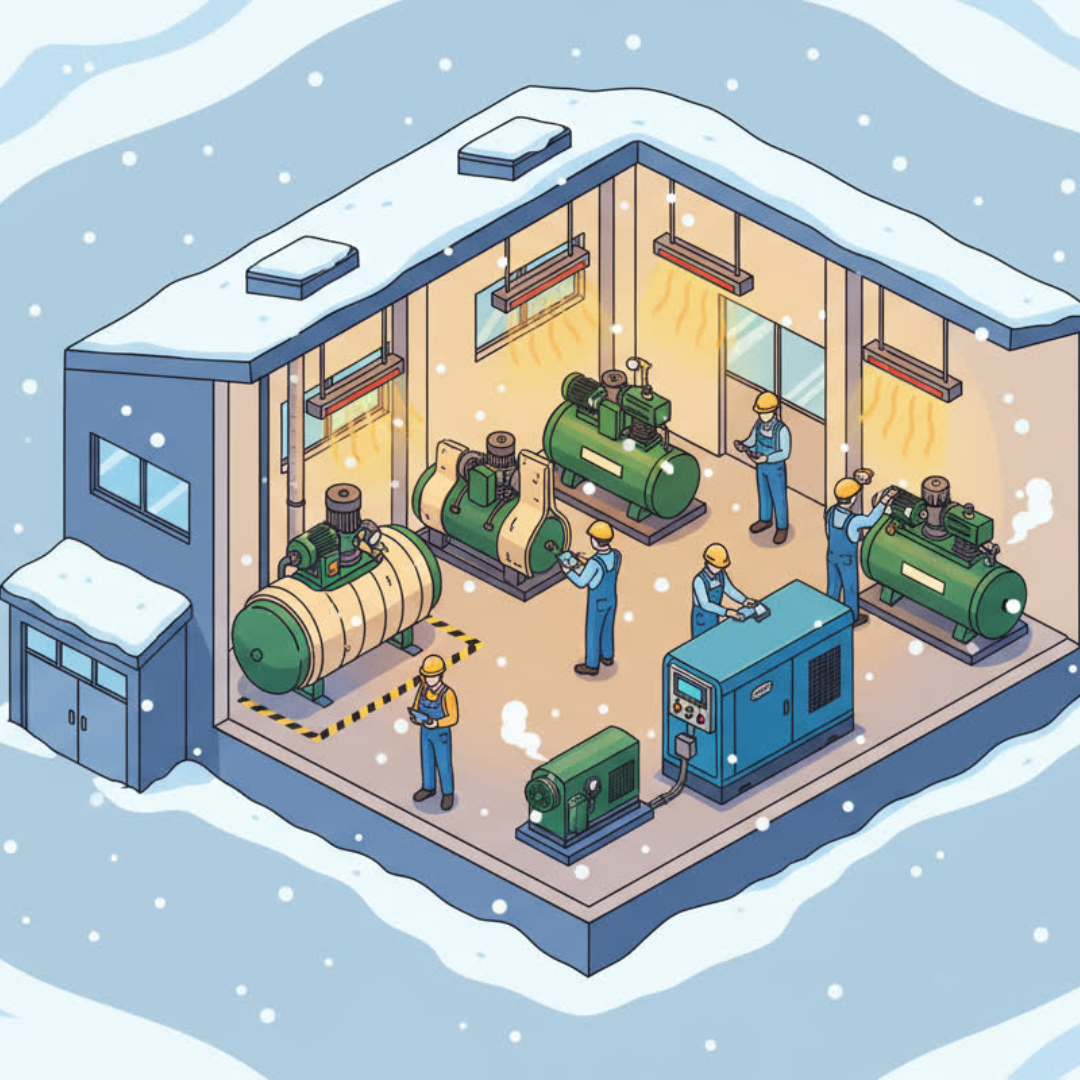Winterizing Your Compressed Air System: The Complete Cold-Weather Maintenance Guide
Posted by Industrial Air Centers on 10/16/2025
When temperatures drop, compressed air systems face some of their toughest operating conditions. Cold weather thickens lubricants, freezes condensate, trips dryers, and cracks piping, all of which lead to downtime and unnecessary cost.
This guide covers everything you need to prepare your compressed air system for winter: from facility-wide audits to equipment-specific steps across compressors, dryers, drains, filters, and piping. Whether you manage rotary screw, piston, or outdoor installations, these tips help keep your air supply reliable all season long.
Shop IAC’s Complete Product Catalog, contact us via online form, or call us at 877-IAC-SERV for hands-on service and support.
→ Create a business account to simply future orders, discounted pricing, multi-user access, and more

How Cold Affects Compressed Air: Dew Point, Viscosity, and Materials
Cold air holds less moisture, which means condensation can form faster, and freeze, inside your system after expansion. If the dew point of your air is higher than the ambient temperature, ice will form in lines, drains, and valves.
At the same time, lubricants thicken in cold conditions. Higher viscosity creates harder starts, higher amperage draw, and increased bearing stress. Elastomers and seals can contract, and sensors may drift out of calibration.
Without proper preparation, those conditions translate into frozen drains, iced dryers, and component wear. Planning several weeks before the first freeze prevents costly shutdowns later.
→ Explore all Parts & Accessories or shop Air Dryers & Filtration to prepare your system for changing conditions.
30–60 Days Out: Your Pre-Winter Audit
Before temperatures drop, benchmark your current system performance. Record discharge pressure, temperature, amperage, and dew point. Walk down your compressor room and main headers to document baseline readings.
Next, perform a leak audit. Leaks are more expensive in winter because compressors run harder to compensate for colder, denser air. Fixing them before the season begins saves both energy and wear.
Finally, identify ambient risks, doors left open to the outside, draft paths, unheated mezzanines, or outdoor piping runs. If your team doesn’t have the bandwidth, IAC’s specialists can perform a Complete Plant Audit to prevent problems before the cold weather takes full effect on your operations.
Compressor Room Strategy: Temperature, Intake Air, and Enclosure Care
- Manage Temperatures: Keep the compressor room temperature above the OEM’s minimum ambient rating, typically 45–50°F for most units. Avoid recirculating hot discharge air back into the same room, it may seem efficient but often creates pressure fluctuations and moisture problems.
- Balance Airflow: Adjust louvers and ducting for winter operation, ensuring balanced airflow without creating negative pressure that starves intake air.
- Maintain Cabinet Cleanliness: Replace or upgrade cabinet filters to prevent snow and dust from entering electrical panels. Verify that space heaters in control cabinets are working, and review alarm setpoints for both high and low temperatures.
Lubricants: Selecting and Managing for Cold Starts
Lubricant performance drops rapidly in cold conditions. Choose compressor-grade lubricants with low pour points designed for your climate. Synthetic PAO-based or food-grade FGXL lubricants offer strong cold-start protection.
- IAC’s quick winter picks include Para-Lube PAO and FGXL food-grade oils, both engineered to maintain viscosity at low temperatures. Always follow OEM viscosity charts for your ambient range.
→ Explore IAC's house-branded lubricants or all air compressor oils offered on our online catalog. For PAG-based systems, search “PAG” in the Lubricants catalog.
- Never mix PAG with PAO or mineral oils. If switching lubricants, complete a full system flush before refilling.
- Change oil and filters on schedule and sample periodically to check for moisture contamination from short runs.
Filtration and Intake Protection
- A clogged intake filter restricts airflow, increasing energy consumption and the risk of icing downstream. Replace intake filters before winter and keep spares on hand.
- Ensure inline filtration stages are configured correctly before the dryer, including coalescing and particulate filters. Monitor differential pressure (DP) to spot blockages.
- At the point of use, maintain filters, regulators, and lubricators (FRLs). Drain bowls daily and adjust regulators to avoid tool freeze-ups.
Dryer Strategy: Refrigerated vs. Desiccant in Freezing Conditions
- Refrigerated dryers perform well above 40°F but can freeze at lower ambients. Ice buildup on the evaporator can block flow and damage the compressor. If your system operates near freezing temperatures, insulate the dryer area or switch to a desiccant unit. Never run refrigerated dryers below freezing.
- Desiccant dryers are designed for sub-zero dew points and include heaters and purge controls that must be checked before winter. Inspect check valves, mufflers, and dew point sensors to ensure proper operation.
- Membrane dryers, often used for instrument or point-of-use air, require efficient prefiltration to prevent liquid water or oil from reaching the membrane. Ensure continuous purge air and route purge lines to avoid icing. In sub-freezing environments, insulate or house the dryer.
- Don’t forget to inspect to oil/water separators downstream to prevent frozen condensate in low points.
Condensate Drains: The #1 Freeze Failure to Prevent
Condensate drains are the most common winter failure point. Mechanical float drains and unheated lines can freeze quickly, leading to water carryover, rusted tools, and equipment damage.
- Switch to heated or insulated drain lines or relocate traps to warm areas. Smart zero-loss electronic drains are the best choice for preventing freeze failures and minimizing air loss.
- Create a regular drain inspection schedule and stock spare kits to replace failed valves immediately.
→ Shop IAC’s condensate drain options or browse our full selection of drains, including electronic and zero-loss models.
Piping and Drops: Insulation, Slope, and Heat Trace
- Insulate exposed mains and maintain slope toward low-point drains. Dead legs and flat runs allow condensate to collect and freeze.
- For outdoor or unheated warehouse piping, apply heat trace systems to prevent freezing. Protect quick-connect fittings and washdown areas with insulation wraps or covers.
- When upgrading, consider aluminum piping systems like Infinity, TruLink, or AIRpipe for better reliability and lower leak rates. Always use certified installers for system modifications.
- After any piping change or seasonal repair, schedule a leak audit to document and eliminate new leaks so you reclaim CFM and cut winter energy waste.
→ Learn more about IAC’s piping installation services, contact the team online, or call 877-IAC-SERV for support.
Instrumentation and Protection: Valves, PRVs, Sensors, and Panels
- Safety and reliability start with working pressure relief valves. Test and verify that PRVs operate within spec, never bypass or plug them.
- Check pressure switches, temperature probes, and transducers for accurate readings, as cold temperatures can cause drift. Replace or recalibrate any sensors out of range.
- Keep control panels dry. Replace cabinet filters and verify that heaters are functioning to prevent condensation inside electrical enclosures.
→ Find safety valves, pressure switches, temperature probes, dew point sensors, and transducers on IAC’s online catalog.
Outdoor or Remote Units: Enclosures, Warm-Up, and Spares
Outdoor compressors require extra attention.
- Use weather enclosures to protect units from wind and snow.
- Before starting, preheat lubricant with sump heaters and allow an extended no-load warm-up period. Keep intakes shielded to prevent snow ingestion.
- Maintain a winter spares kit that includes belts, filters, drain kits, lubricants, heater elements, and pressure or temperature sensors.
- Have an emergency plan in place for rental support, including where to connect temporary air or power tie-ins.
→ IAC’s 24/7/365 emergency services offer around-the-clock, reliable help from experts you can count on.
Startup and Operating Checklist for Freezing Temps
- Before starting, perform a quick visual inspection and follow proper lockout/tagout (LOTO) procedures. Ensure all drains are clear, dew point is below ambient, heaters are on, and fan rotation is correct.
- During startup, allow a no-load warm-up and then ramp up to full load gradually. Verify amperage, temperature, and pressure bands.
- Daily: Blow down low points, check drains, record dew point, and inspect cabinet filters.
- Weekly: Test safety relief valves, inspect intake filters, and review room temperature.
- If pressure sags or temperature spikes, shut down safely and investigate before restarting.
→ Learn more about IAC’s repair & troubleshooting services for replacement components or professional support.
The Winter Stocking List: Parts and Accessories to Have on Hand
Keep critical spares in stock before winter hits.
Must-Haves
- Lubricants in the correct winter grade
- Intake, inline, and coalescing filters
- Electronic drain kits and cabinet filters
- Heater elements, desiccant, PRVs, gaskets, and seals
Nice-to-Haves
- Spare pressure switches
- Temperature probes
- Belts
- Hose fittings
- Thread sealant
- Insulation wraps
- Heat-trace kits
→ Shop IAC’s full online catalog and create a business account with IAC for faster checkout, business pricing, and re-order lists, making it easy to restock essentials all winter long.

When to Bring in IAC: Service, Rentals, and Ongoing Support
If you notice repeat drain freezes, dryer icing, or dew point instability, call professional support, like IAC’s expert service team. Our technicians can diagnose the root cause and stabilize performance before peak winter demand.
If repairs require downtime, rentals keep production running without disruption. IAC’s rental fleet includes portable compressors, dryers, and pumps available for immediate delivery.
For long-term stability, Service Agreements lock in preventive maintenance schedules and energy audits. Consistent service keeps your system efficient, even during extreme cold.
Winterproof Your Compressed Air System Right
To Summarize
- Winterizing your compressed air system starts with understanding how temperature impacts moisture, viscosity, and materials.
- From there, perform a pre-winter audit, manage room temperature and intake air, select the right lubricants, and verify filtration, dryers, drains, and piping.
- Finish with a strong startup checklist and stocking plan. A few hours of prep now can save thousands in downtime later.
→ Shop Parts & Accessories, schedule a Complete Plant Audit before the cold weather kicks in, or explore IAC’s Compressed Air as a Utility program to keep your system running smoothly this winter.
→ Contact IAC here or call 877-IAC-SERV to talk through your facility's needs or immediate support.
Safety Notes
- Always isolate and depressurize the system before performing maintenance.
- Follow OSHA lockout/tagout (LOTO) procedures before working on any equipment.
- Verify zero pressure before removing lines or filters.
- Wear eye and hand protection when draining condensate or handling lubricants.
- Follow all OEM safety procedures for operation, testing, and disposal.
